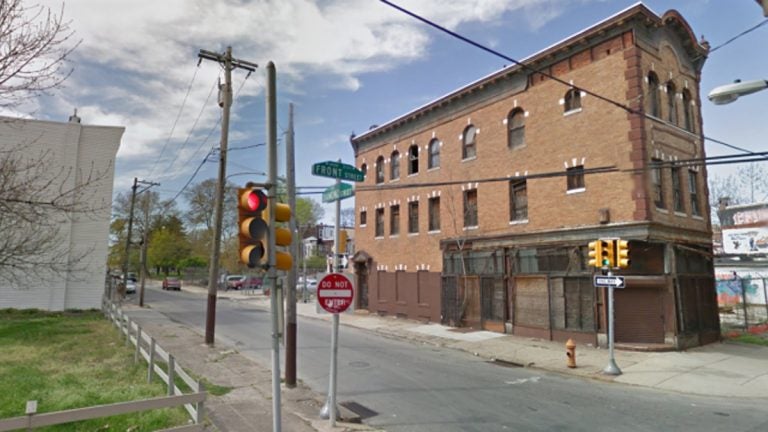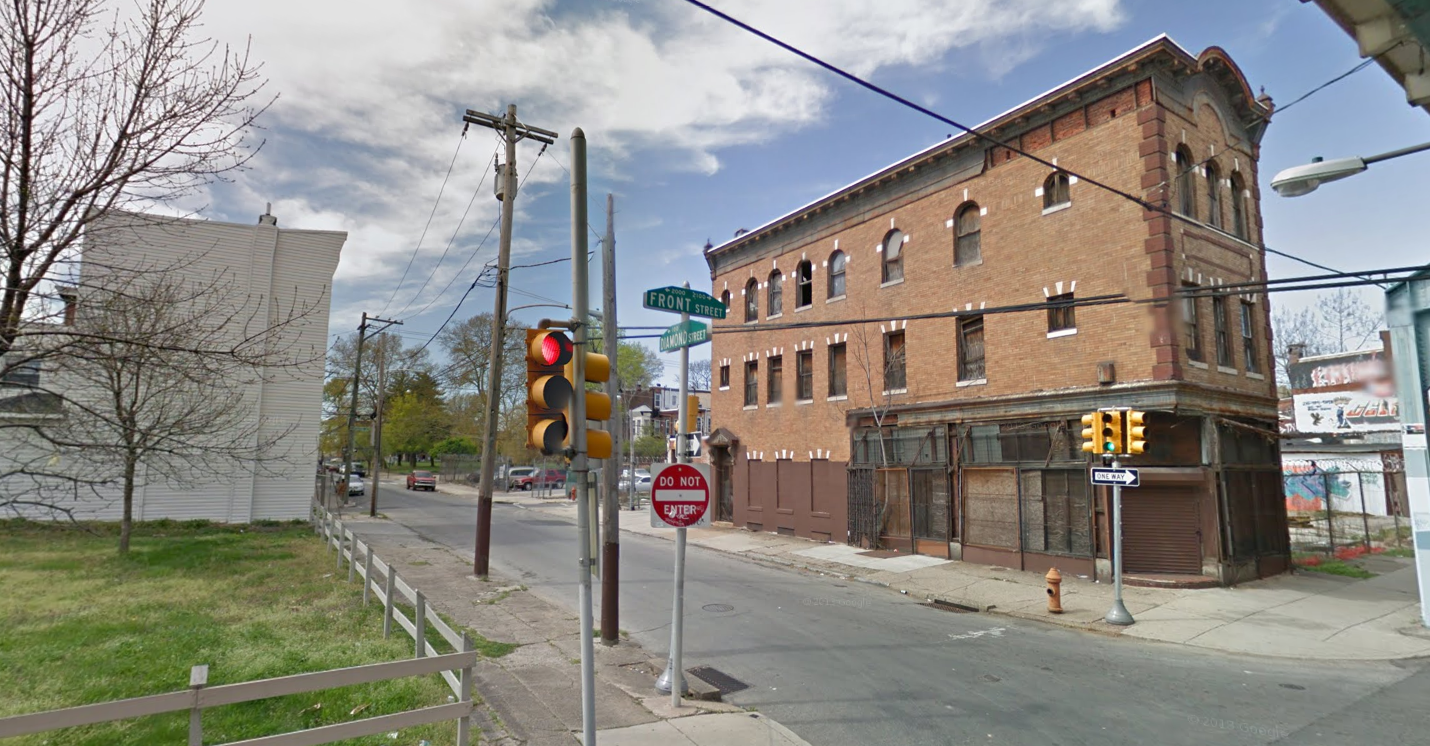Methadone clinic approved for Front and Diamond streets

Front and Diamond streets, Philadelphia (PlanPhilly Image)
The Zoning Board of Adjustment approved a proposal Wednesday to move Kensington Hospital’s methadone treatment program into a vacant building at the corner of Front and Diamond streets.
The vote was 3-1, with board member Martin Bednarek voting in opposition.
The hospital was seeking a special exception for a medical-office use in a CMX-2 zoning district, as well as a small dimensional variance for a portion of the elevator structure that will reach about a foot and a half above the 38-foot height limit.
The proposal was supported at the zoning board by members of Norris Square Civic Association (NSCA), a Registered Community Organization and community development corporation that works in the area. Councilwoman María Quiñones-Sánchez, who represents the area, also supported the proposal.
“For many years I have personally been a close neighbor of Kensington Hospital, and in my experience they have shown themselves to be an asset to our community,” Councilwoman Sánchez wrote in a letter to the board. “… I do not think it is wise to follow the trend exhibited elsewhere in the city to obstruct the presence of treatment facilities, which prevents our fellow citizens from accessing urgently-need care.”
But the new location for the center also falls within the boundaries of another RCO, East Kensington Neighbors Association (EKNA), and representatives of that group oppose the proposal itself and feel shut out by the process leading up to Wednesday’s decision.
At a contentious combined meeting between the Norris Square and East Kensington RCOs, attendees voted 54-8 to oppose the zoning relief for the project, said John Theobald, chair of EKNA’s zoning committee. Despite the initial opposition—one member of NSCA testified on Wednesday that she initially voted against the project, but later decided to support it—the hospital later worked with NSCA to put together a public safety plan for the operation of the program, as well as a “Community Partnership Agreement.”
EKNA maintained its opposition. Carl Primavera, an attorney for the hospital, asked Theobald why he didn’t hold more meetings with the applicant to try to find common ground. Theobald responded that he felt it was his role as the zoning chair for an RCO to represent his membership’s vote, not to work out “side agreements” with developers.
The agreement referred to in NSCA’s support letter says that a Norris Square Community Advisory Board will be formed to periodically review the operations of the new treatment center. At the hearing Wednesday, board chair Julia Chapman asked that East Kensington Neighbors Association be explicitly mentioned in the formation of that advisory board.
The hospital currrently has a license to treat up to 200 patients daily, but only has between 130 and 160 patients enrolled, according to representatives of the program. The new facility would have the physical capacity to treat 300 patients, but the program would need to update its license in order to enroll more than the 200 currently allowed. Dr. Stephen Clay, director of the hospital’s methadone treatment program, said he doesn’t expect a quick or steep increase in the number of patients.
The program also will expand its hours at the new facility. Currently, the program operates from 6 a.m. till 2 p.m. It will operate from 6 a.m. till 5 p.m. at the new building.
WHYY is your source for fact-based, in-depth journalism and information. As a nonprofit organization, we rely on financial support from readers like you. Please give today.
Methadone clinic approved for Front and Diamond streets

The Zoning Board of Adjustment approved a proposal Wednesday to move Kensington Hospital’s methadone treatment program into a vacant building at the corner of Front and Diamond streets. The vote was 3-1, with board member Martin Bednarek voting in opposition.
The hospital was seeking a special exception for a medical-office use in a CMX-2 zoning district, as well as a small dimensional variance for a portion of the elevator structure that will reach about a foot and a half above the 38-foot height limit.
The proposal was supported at the zoning board by members of Norris Square Civic Association (NSCA), a Registered Community Organization and community development corporation that works in the area. Councilwoman María Quiñones-Sánchez, who represents the area, also supported the proposal.
“For many years I have personally been a close neighbor of Kensington Hospital, and in my experience they have shown themselves to be an asset to our community,” Councilwoman Sánchez wrote in a letter to the board. “… I do not think it is wise to follow the trend exhibited elsewhere in the city to obstruct the presence of treatment facilities, which prevents our fellow citizens from accessing urgently-need care.”
But the new location for the center also falls within the boundaries of another RCO, East Kensington Neighbors Association (EKNA), and representatives of that group oppose the proposal itself and feel shut out by the process leading up to Wednesday’s decision.
At a contentious combined meeting between the Norris Square and East Kensington RCOs, attendees voted 54-8 to oppose the zoning relief for the project, said John Theobald, chair of EKNA’s zoning committee. Despite the initial opposition—one member of NSCA testified on Wednesday that she initially voted against the project, but later decided to support it—the hospital later worked with NSCA to put together a public safety plan for the operation of the program, as well as a “Community Partnership Agreement.”
EKNA maintained its opposition. Carl Primavera, an attorney for the hospital, asked Theobald why he didn’t hold more meetings with the applicant to try to find common ground. Theobald responded that he felt it was his role as the zoning chair for an RCO to represent his membership’s vote, not to work out “side agreements” with developers.
The agreement referred to in NSCA’s support letter says that a Norris Square Community Advisory Board will be formed to periodically review the operations of the new treatment center. At the hearing Wednesday, board chair Julia Chapman asked that East Kensington Neighbors Association be explicitly mentioned in the formation of that advisory board.
The hospital currrently has a license to treat up to 200 patients daily, but only has between 130 and 160 patients enrolled, according to representatives of the program. The new facility would have the physical capacity to treat 300 patients, but the program would need to update its license in order to enroll more than the 200 currently allowed. Dr. Stephen Clay, director of the hospital’s methadone treatment program, said he doesn’t expect a quick or steep increase in the number of patients.
The program also will expand its hours at the new facility. Currently, the program operates from 6 a.m. till 2 p.m. It will operate from 6 a.m. till 5 p.m. at the new building.
WHYY is your source for fact-based, in-depth journalism and information. As a nonprofit organization, we rely on financial support from readers like you. Please give today.


